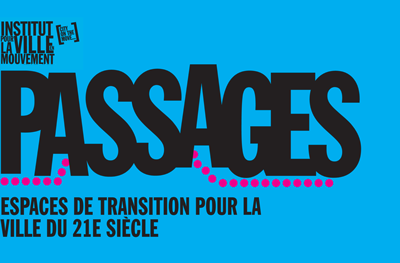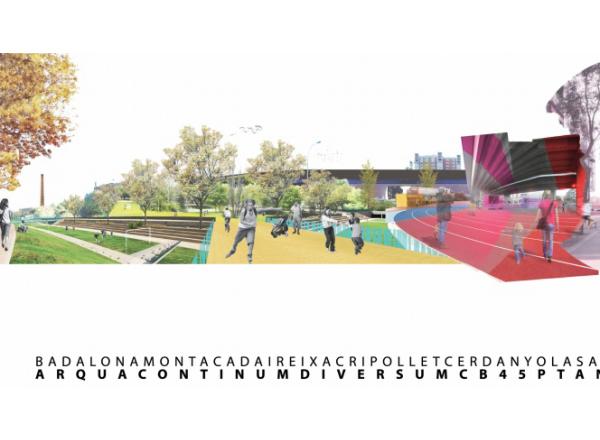Enric Batle
Article published in the catalogue of results edited by the AMB : analysis of the results for the 6 competitions
Enric Batlle, architect, professor, jury member for the 6 competitions
‘From the earliest days, passages have helped human beings to cross barriers’. This is the opening phrase of the Marcel Smets article that provided guidance for participants in the recent Metropolitan Passages competition.
Public spaces promoting movement have become the most highly desired of urban spaces: those that allow you to stroll between different parts of the city and that offer the chance to access, from the different urban fabrics making up our metropolis, the different natural and agricultural spaces we still retain. However, our metropolis is still full of insurmountable restrictions: like curtain walls, they block connectivity between its parts. Resolving these blockages has become one the of the most strategically important projects we can undertake; a project that will allow the mesh to work and the different flows (ecological, urban and metropolitan) to actually flow. It means focusing more attention on the most difficult point rather than enjoying ourselves on one of the two sides. These places become the ‘missing link’ in the chain, the passageway between two fragmented situations that can be seen as the ‘military points’ analyzed by Richard T. T. Forman in Land Mosaics; places upon which all our activities must be concentrated, because we know that, if we are able to solve them, we shall ensure that a huge territory falls within our reach.
A metropolis can be defined as a set of flows—as Joan Busquets suggests, what we need are meshes, not centers—and, perhaps, the projects that are most necessary are those involving the different infrastructures: communications and transport, energy and information, but also green ones.
Development of environmental meshes and the establishment of itineraries that permit slow-moving mobility (pedestrians, cyclists, etc.) are two of the main actions that can help us to hybridize our cities between each other and with the possible metropolitan urban matrix. Ecological, urban and metropolitan continuities must become the source of every new decision we take. Pedestrians, cyclists, public transport, water and life must flow through the metropolis, and could represent one of the best strategies for every new project carried out.
The competition suggests taking a small-scale look at metropolitan projects. Ramon Folch defined scale as not so much the size of things, but rather their character and makeup, whilst landscape architect Michel Corajoud called on us to carry out a “traversée des échelles”, working simultaneously on the whole and on the details, the close-up and the long-range. Metropolitan landscapes would thus come into play on all scales, and can be built from the small scale, with ad hoc projects (which aim to resolve the interruptions we seek to boost), but which become key components of a greater system that can only be understood from the metropolitan large scale.
The competition has focused on six different metropolitan environments. All six are highly complex spaces, with their obstacles and their discontinuities, but also boast great potential: for a convergence of activities and uses, for contact between urban, industrial and rural fabrics and for the overlapping of communications (old remains, motorways, urban roads and paths), and this means special attention must be paid to slow-speed, ‘soft’ mobility and to incorporating activities associated with metropolitan itineraries.
The result of the competition has allowed us to see how people work on different cases and helped us to draw up a kind of catalogue of thoughts, strategies and possible actions concerning this type of place. All the prizewinning projects have allowed us to examine six different ways of tackling the issues involved in metropolitan passages.
Site 1A – A passage across the C31, in the town ofBadalona, received three Special Mentions from the jury: one for the project UNBREAKING BADALONA, with a connective itinerary that enhances the value of existing spaces via small-scale works associated with the emotional history of the district; another for PAISATGE INFRAESTRUCTURAL, which proposes a modular system of ‘urban activity containers’ that fit the topography and that collect the opinions of the district’s inhabitants, and a third, meriting a special comment, for the project ARQUA, a proposal for a ‘Hydro-urban Park’ as a single strategy that integrates and solves all the site’s issues whilst offering an itinerary as a metropolitan passage along the green corridor of the Torrent de la Font stream. Considered particularly noteworthy was the geographical nature of this proposal, which aims to boost connectivity between the different districts and reclaim the stream as a passage.
Site 1B: A connecting passage, in the town of Montcada i Reixac, received two First Prizes: one for the project BY PASS, which proposes a long-term transformation by means of a metropolitan connective space that helps boost the continuity of urban fabrics, using the different existing interruptions, and another for ESPAI ‘CONTINUM’, ACTIVITAT ‘DIVERSUM’, positively appreciated because it is an immediate, adaptable and viable action that, in an economically feasible way, manages to substantially improve the quality of the urban space. This project focuses opportunities on a magnificent (but undervalued) empty space, that under viaducts, based on simply emptying it of vehicles and on a minimal yet powerful graphical and visual intervention, very much in line with the ephemeral nature of Land Art.
Site 2C: The passage as a civic axis, between the towns of Ripollet and Cerdanyola del Vallès, was awarded two Special Mentions and one First Prize. One Special Mention was for 1,2,3, for the architectural solution proposed for the surroundings of Ripollet, and the other for the project DE CAJÓN, in recognition of its attempt to restore the city’s relationship with the river by using a significant infrastructure work that would modify the current section of the motorway.
The First Prize, for CB45PT, was for its recognition and resolution, with the greatest focus, of all the issues and for concentrating efforts on building a new passing point directly connecting the bridge with the river and the city. This project shows the Infrastructure -related element required by all passages to ensure that they overcome the discontinuities created by other infrastructures.
Site 2D: The passage as an interurban promenade, between the towns of Sant Cugat del Vallès and Rubí, saw the jury awarding a First Prize to the project ANELL VERD (GREEN RING) for its recognition of ecological connectivities as a viable alternative to current urban mobility routes. The environmental nature of the project, which enhances the ecological and social connectivity between the two sides of the AP-7 toll motorway, did not affect the jury’s surprise that none of the proposals submitted tackled the issue of the old Rubí road by simply transforming this section.
Site 3E: The passage as a centrality node, between the municipalities of Sant Vicenç dels Horts and Molins de Rei, received three Special Mentions and one First Prize. One Special Mention was for the project FILAR PRIM, acknowledging the powerful treatment given the junction and the interesting relationship established with the station.
Another Special Mention was awarded to the project RECICLAR EL PAISAJE TECNOCRÁTICO, for the possibility of recycling part of the existing infrastructure whilst at the same time configuring a new urban space. The third Special Mention was given to the project FÒRUM KM0, for its recuperation of the relationship between Sant Vicenç and the Agricultural Park. For its part, the First Prize was awarded to PASSATGE A LA IDENTITAT, in recognition of the URBAN nature of the approach of changing a section of the current infrastructure to enhance its civic nature, both along the bridge and at its contact points with the two towns.
Lastly, site3F: The passage as a metropolitan interchange, in l’Hospitalet de Llobregat, was the recipient of two Special Mentions and one First Prize. One Special Mention was awarded to ON TOT POT PASSAR in recognition of the simplicity of its buried plaza passage, and the other to the project VINCLE, for its work on urban continuity with a green passage that acknowledges existing public spaces.
The First Prize, for the project LES VIDES AL PONT, showed our appreciation of how a wide variety of solutions can be developed in answer to the same issue. The ARCHITECTURAL quality of the proposal is based around a building-passage able to house different uses and adaptable to fit the possible future transformations of the location.
The GEOGRAPHICAL, EPHEMERAL, INFRASTRUCTUREREL ATED, ENVIRONMENTAL, URBAN and ARCHITECTURAL qualities highlighted in our analysis of the six sites could provide a catalogue of solutions for spaces lacking continuity and featuring barriers that hinder interaction and integration or that prevent easy, efficient mobility, in terms of both their metropolitan nature and their closer realities.
These passages, built on the basis of reclaiming the original geography of the site, of the immediate nature of graphical and visual work, of the implementation of the right kind of pedestrian bridge, of the establishment of an environmental network, of the conversion of a public space or the correct location of a bridge building, should allow us to achieve a network of open spaces that acts as the backbone of a metropolitan territory. A combination of streets, squares and parks that would connect the different parts with one another and with the agricultural and natural spaces we still retain.
Marcel Smets notes how the Passage becomes an emblematic place, a place that renders account of the journey as a whole, because it has an impact that far exceeds the small effort involved (that called for by the actual building of the passage itself). Becoming involved in the resolution of a passage allows us to perfect the general mobility system and urban quality in particular. As Smets says, ‘Given that mobility spaces have today become the main centers of public encounter, the impact of a well-designed passage radiates to the quality of urban life as a whole’.

